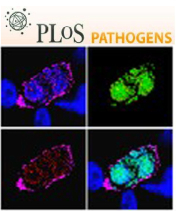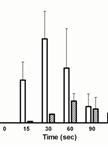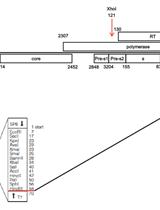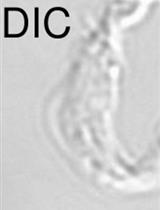- EN - English
- CN - 中文
Evolution of Escherichia coli to Macrophage Cell Line
大肠杆菌向巨噬细胞系的演化
发布: 2014年09月05日第4卷第17期 DOI: 10.21769/BioProtoc.1227 浏览次数: 11185
Abstract
The genomes of species of Escherichia coli (E. coli) show an extraordinary amount of diversity, which include commensal strains and strains belonging to different pathovars. Many strains of E. coli, which can cause mild or severe pathologies in humans, have a commensal ancestor. Understanding the evolutionary changes that can lead to a transition from commensal to pathogen is an important task, which requires integration of different methodologies. One method is experimental evolution of bacteria, in controlled environments, that mimic some of the selective pressures, likely to be important during the transition to pathogenesis. The success of such a transition will depend, at least partially, on ability of E. coli to adapt to the presence of cells of the immune system. Here, we describe a protocol for performing experimental evolution of a commensal strain of E. coli, a derivative of the well studied K12, under the constant selective pressure imposed by cells of the innate immune system, specifically RAW 264.7 murine macrophage cell line.
Keywords: Experimental evolution (实验性的进化)Materials and Reagents
- RAW 264.7 murine macrophage cell line (MΦ) (Sigma-Aldrich, catalog number: 91062702 )
- E. coli strains, marked with constitutive expression of yellow (YFP) and cyan (CFP) fluorescent proteins (e. g. E. coli- MC4100, galK::CFP/YFP, AmpR StrepR)
- RPMI media1640 (Life Technologies, Gibco®, catalog number: 11875-093 )
- 2-mercaptoethanol solution (Life Technologies, InvitrogenTM, catalog number: 31350-010 )
- 1 M Hepes buffer (Life Technologies, InvitrogenTM, catalog number: 15630-056 )
- 100 mM sodium pyruvate (Life Technologies, InvitrogenTM, catalog number: 11360-039 )
- Heat-inactivated Fetal Bovine Serum (FBS) (Life Technologies, Gibco®, catalog number: 10500-064 )
- GlutaMAX (100X) (Life Technologies, Gibco®, catalog number: 35050-038 )
- 10,000 U/ml penicillin/streptomycin (Life Technologies, Gibco®, catalog number: 15140-122 )
- Streptomycin sulfate salt (Sigma-Aldrich, catalog number: S9137 )
- 50 mg/ml gentamycin solution (Sigma-Aldrich, catalog number: G1397 )
- 1x phosphate-buffered saline (PBS)
- Trypan Blue solution (Sigma-Aldrich, catalog number: T8154 )
- CpG-ODN -1826 (5´-TCCATGACGTTCCTGACGTT-3´) (Sigma-Aldrich)
- RPMI-complete media (see Recipes)
- RPMI-Strep media (see Recipes)
Equipment
- CO2 incubators
- Microscope
- Luria-Bertani (LB) agar plates (Panreac Life-sciences, catalog number: 596661.1210 )
- Centrifuge (Sigma-Aldrich, model: 4K15 with a rotor 11150 )
- Neubauer cell counting chamber (VWR International, catalog number: 631-1114 )
- Air flow chamber
- 12-well microtiter plates (Costar, catalog number: 3513 )
- Cell culture flasks (25 cm2 and 75 cm2 growth area) (Corning, catalog numbers: 430639 and 430641 )
- 15 ml Falcon tubes
- Cell scrapers (16 cm and 25 cm) (SARSTEDT AG, catalog numbers: 83.1832 and 83.1830 )
- 2 μm size beads (Sphero AccuCount Blank Particles) (Spherotech, catalog number: ACBP-20-10 )
- LSR Fortessa Flow cytometer
Procedure
文章信息
版权信息
© 2014 The Authors; exclusive licensee Bio-protocol LLC.
如何引用
Readers should cite both the Bio-protocol article and the original research article where this protocol was used:
- Miskinyte, M. and Gordo, I. (2014). Evolution of Escherichia coli to Macrophage Cell Line. Bio-protocol 4(17): e1227. DOI: 10.21769/BioProtoc.1227.
- Miskinyte, M., Sousa, A., Ramiro, R. S., de Sousa, J. A., Kotlinowski, J., Caramalho, I., Magalhaes, S., Soares, M. P. and Gordo, I. (2013). The genetic basis of Escherichia coli pathoadaptation to macrophages. PLoS Pathog 9(12): e1003802.
分类
微生物学 > 微生物-宿主相互作用 > 细菌
微生物学 > 微生物遗传学 > DNA > DNA 复制
分子生物学 > DNA > 基因分型
您对这篇实验方法有问题吗?
在此处发布您的问题,我们将邀请本文作者来回答。同时,我们会将您的问题发布到Bio-protocol Exchange,以便寻求社区成员的帮助。
Share
Bluesky
X
Copy link













